Deep Sky Altair 294C ProTEC
Only used for a short time then
sold on - see bottom of page
Many years ago (2009) I briefly owned a one
shot colour camera. An SBIG ST4000. Nice
camera, but the sensor was extremely noisy and proved problematic for
processing, so although I acquired some nice images I didn't keep it
for very long. Since 2012 I have been happily using my QSI
683. With the passage of time and climate change, imaging
opportunities have become fewer, and CMOS sensors have improved
out of all recognition. So in February 2022 I purchased (secondhand
in excellent condition) a one shot colour Altair CMOS camera.. This
particular camera sensor is almost exactly the same size as my QSI
683, so no worries about obtaining flat fields of view with my
existing telescopes etc.
I wished to set it up for off-axis guiding and initially used my
venerable Celestron unit which had seen almost no use in recent
years. I was able to make a spacing adaptor to be parfocal with the
294C and Lodestar guide camera, and also made a spacer to use the
294C with my Canon lenses for wide angle.
The camera arrived on 15 February but with a full Moon on 16th I
had to wait a week before attempting any dark sky imaging. For all
the images below I have only linked to medium size enlargements.
Although this camera could be used binned with the Altair ASCOM
driver without losing colour data, binning was not additive, so no
advantage depth wise. And I found that the large unbinned files took
a heavy toll in processing so also tried binned 2x2. Made very little
difference to the final image. For some of the images I was unable to
set the correct spacing for the TS2 field flattener with my TMB 105
refractor - the off-axis guider introduced too much back focus so the
stars were slightly distorted. More investment needed!
|
22nd February was a decent night and with the Moon not
rising until after 2 am I set to. This first image was of
M45 - the Pleiades in Taurus. 12 x 5 minute subs unbinned.
Quite pleasing, but of course a bright target.
|
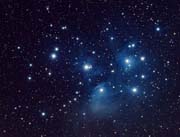
|
|
I then moved on to M42, the Orion nebula. Again a bright
target, and 9 x 5 minute unbinned exposures proved
sufficient. I also took 2 minute subs to try and bring out
the trapezium, but it was still 'blown out'. A reasonable
image, but rather 'noisy' and lacking in fine detail. Both
using the SX AO unit, SX Lodestar guider and
TS quad telescope.
|
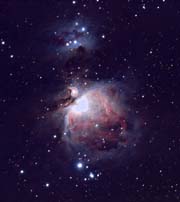
|
|
Mag 12 NGC 2968 in Leo is of particular interest with the
nice spiral mag 11 NGC 2964 below and a faint tidal star
trail between 2698 and the smaller mag 13.7 NGC 2970. I had
hopes on a dark night of 27th February, and took 19 x 10
minute unbinned subs. But to no avail. No sign of the star
trail, and a rather disappointing lack of detail in the
galaxies - possibly down to poor seeing.
|
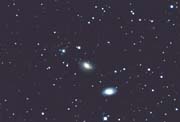
|
|
From 28th April I spent a few days at the Drumroamin Farm
camp site Galloway Star Party. Wonderful dark skies there,
and again I had hopes for a faint target, the 'Dust Angel'
nebula in Draco. But again despite 19 x 10 minute binned
subs, very disappointing - essentially a star field with
only the faintest hint of background colour after much
processing. I had a 2 year old image taken with my QSI
camera, so used that for a composite here.
So it was not altogether wasted.
|

|
|
Following the Galloway visit I was at Kielder for a
weekend, and again took the 294 for further trials. On 5th
March I took 9 x 5 minute and 7 x 10 minute subs of the Leo
Trio, all unbinned on the TMB 105. Not too bad, but close
examination revealed a lot of noise.
|
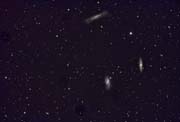
|
|
Finally on 7th March an image of the beautiful mag 10
spiral galaxy NGC 3198 in Ursa Major. This of course using
my RC10 at home. 9 x 10 minute subs, unbinned. Quite
acceptable, but fine detail lacking compared to the same
target using my QSI camera on 6th
and 25th March.
|
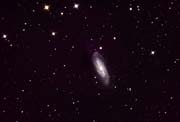
|
Well, as you can see, not very many images and only those of
brighter targets really acceptable. I probably expected too much of
the one shot colour system after many years of using monochrome with
its finer detail advantage. And also probably expected too much of
the vaunted sensitivity of the modern CMOS chips. I think part
of the difficulty I was having was down to my somewhat out of date
computers (still using Windows XP for capture - if it ain't broke,
don't fix it!), although my W7 desktop flies along quite well.
A bit 'noisy' at times, but I suspect that if I had more powerful
computers I would have gone for many more but shorter sub frames -
that would seem the way many people use these cameras. Also to fully
realise the potential with my existing optics would have meant
considerable further expenditure, and almost certainly still not
produce images as good as I obtain with my QSI
CCD camera. So the decision was taken to sell the camera on,
which was done with little delay and very little monetary loss. But
worth a try and good practise making parts and modifying the
Celestron off-axis guider which is now a little more useable!





